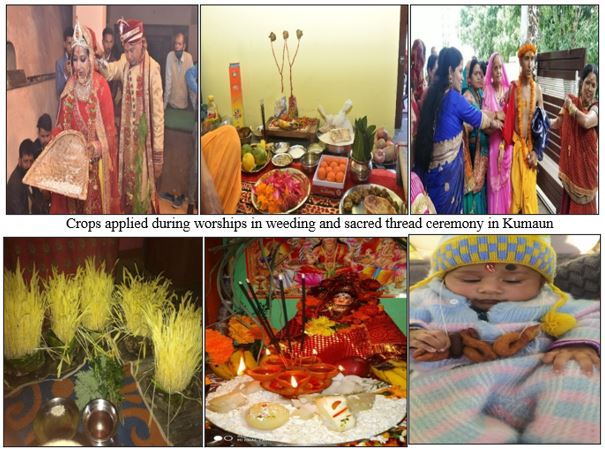Diversity, Religious Significance and Nutritional Potential of Traditional Cereals and Millets in the Indian Himalayan Region
DOI:
https://doi.org/10.5281/zenodo.16670454Keywords:
IHR, tradition cereals and millets, Kumaun religious activities, conservationAbstract
The Indian Himalayan Region (IHR), with its diverse agroecological zones and rich cultural heritage, supports a unique integration of agriculture and spirituality. This study explores the distribution and religious applications of 11 traditional crops of IHR which includes seven millets and four cereal species. These grains, belonging to the Poaceae family, play significant roles in traditional ceremonies, seasonal festivals, and Tantric practices, symbolizing fertility, prosperity, and cosmic balance. The study, based on revisionary surveys, documents their altitudinal adaptability across tropical to temperate zones and emphasizes their ritualistic use in Hindu customs such as weddings, naming ceremonies, and ancestral rites. Nutritional analysis reveals their rich composition, especially in antioxidants, fibers, and essential minerals, with species like Eleusine coracana and Sorghum bicolor offering notable health benefits. The study underscores the grains’ dual role as nutritional staples and cultural artifacts, advocating for the preservation of this ethno-agricultural knowledge amid modern shifts in food systems and cultural practices.
Downloads
References
Das Graças Costa, E., & de Souza, P. M. (2023). Introduction to cereals. in Cereal-based food products. Cham: Springer International Publishing, pp. 1-24.
Bhatt, D.K., Joshi, V. K., & Arora, R. K. (1999). Conodont biostratigraphy of the lower Triassic in Spiti Himalaya, India. Journal Geological Society of India, 54(2), 153-167.
Saleh, A.S., Zhang, Q., Chen, J., & Shen, Q. (2013). Millet grains: nutritional quality, processing, and potential health benefits. Comprehensive Reviews in Food Science and Food Safety, 12(3), 281-295.
Semwal, R. L., & Maikhuri, R. K. (1996). Structure and functioning of traditional hill agroecosystems of Garhwal Himalaya. Biological Agriculture & Horticulture, 13(3), 267-289.
Shahidi, F., & Chandrasekara, A. (2013). Millet grain phenolics and their role in disease risk reduction and health promotion: A review. Journal of Functional Foods, 5(2), 570-581.
Sharma, K. K., & Ortiz, R. (2000). Program for the application of genetic transformation for crop improvement in the semi-arid tropics. in Vitro Cellular & Developmental Biology-Plant, 36, 83-92.
Das, A., Thoithoi Devi, M., Babu, S., Ansari, M., Layek, J., Bhowmick, S. N., & Singh, R. (2018). Cereal-legume cropping system in Indian Himalayan region for food and environmental sustainability. Legumes for Soil Health and Sustainable Management, 33-76.
Chandra, S. (2022). Documentation of the plants used in different Hindu rituals in Uttarakhand, India. Asian Journal of Ethnobiology, 5(2).
Nautiyal, S., Bisht, V., Rao, K. S., & Maikhuri, R. K. (2008). The role of cultural values in agrobiodiversity conservation: a case study from Uttarakhand, Himalaya. Journal of Human Ecology, 23(1), 1-6.
Rawat, S., & Kumar, R. (2024). The enchanting flora of Chamba: unveiling sacred and magico-religious plants in Himachal Pradesh. Ethnobotany Research and Applications, 28, 1-16.
Chandra, S. (2022). Documentation of the plants used in different Hindu rituals in Uttarakhand, India. Asian Journal of Ethnobiology, 5(2).
Ankita, & Seth, U. (2025). Millets in India: exploring historical significance, cultural heritage and ethnic foods. Journal of Ethnic Foods, 12(1), 2.
Boddupalli, R. S. (2024). Traditional knowledge of Vedic grasses-Their significance and medicinal uses. Indian Journal of Traditional Knowledge (IJTK), 23(3), 224-238.
Mahalik, G. Plant resources used in Kartika Purnima for worshipping lord Kartikeya in Odisha, India.
Thakur, S., Jamwal, R., & Negi, S. (2023). Ethnobotanical survey of plants used in magico-religious practices in Kullu district of Himachal Pradesh, India. Ethnobotany Research and Applications, 25, 1-18.
Champion, H. G., & Seth, S. K. (1968). A revised survey of the forest types of India. Manager of Publications.
Lata, S., Sharma, S., & Maurya, C. (2022). Traditional uses of plants in various rituals and ceremonies among Tharu tribe of Udham Singh Nagar, Kumaun Himalaya Uttarakhand, India. Plant Archives, 22(1), 334-342.
Agarwal, p. (2014). Study of sacred plants used by people in Fatehpur district of Uttar Pradesh (India). Life sciences, 54, 91-98.
Sahoo, R. N., Kumar, S., Suryavanshi, A., Kain, D., Arya, A., & Chaudhry, B. (2021). Venerated and medicinal aspects of plants used in India: An ethnobotanical review. Journal of Drug Research in Ayurvedic Sciences, 6(3), 128-140.
Sahu, P. K., Kumari, A., Sao, S., Singh, M., & Pandey, P. (2013). Sacred plants and their Ethno-botanical importance in central India: A mini review. International Journal of Pharmacy and Life Sciences, 4(8), 2910-2914.
Montonen, J., Knekt, P., Järvinen, R., Aroma, A., & Reunanen, A. (2003). Whole-grain and fiber intake and the incidence of type 2 diabetes. The American Journal of Clinical Nutrition, 77(3), 622-629.
Gómez-Cordovés, C., Bartolomé, B., Vieira, W., & Virador, V. M. (2001). Effects of wine phenolics and sorghum tannins on tyrosinase activity and growth of melanoma cells. Journal of Agricultural and Food Chemistry, 49(3), 1620-1624.
Lee, S. H., Chung, I. M., Cha, Y. S., & Park, Y. (2010). Millet consumption decreased serum concentration of triglyceride and C-reactive protein but not oxidative status in hyperlipidemic rats. Nutrition Research, 30(4), 290-296.
Eduru, A., Kamboj, A., Reddy, P. M., & Pal, B. (2021). Nutritional and health benefits of millets, present status and future prospects: A review. The Pharma Innovation Journal, 10(5), 859-868.
Carr, T. P., Weller, C. L., Schlegel, V. L., Cuppett, S. L., Guderian Jr, D. M., & Johnson, K. R. (2005). Grain sorghum lipid extract reduces cholesterol absorption and plasma non-HDL cholesterol concentration in hamsters. The Journal of Nutrition, 135(9), 2236-2240.
Dykes, L., & Rooney, L. W. (2006). Sorghum and millet phenols and antioxidants. Journal of Cereal Science, 44(3), 236-251.
Ciacci, C., Maiuri, L., Caporaso, N., Bucci, C., Del Giudice, L., Massardo, D. R., and Londei, M. (2007). Celiac disease: in vitro and in vivo safety and palatability of wheat-free sorghum food products. Clinical Nutrition, 26(6), 799-805.
Choi, Y. Y., Osada, K., Ito, Y., Nagasawa, T., Choi, M. R., & Nishizawa, N. (2005). Effects of dietary protein of Korean foxtail millet [Setaria italica] on plasma adiponectin, HDL-cholesterol, and insulin levels in genetically type 2 diabetic mice. Bioscience, Biotechnology, and Biochemistry (Japan), 69(1).
Ali, M. A., El Tinay, A. H., & Abdalla, A. H. (2003). Effect of fermentation on the in vitro protein digestibility of pearl millet. Food Chemistry, 80(1), 51-54.

Published
How to Cite
Issue
Section
ARK
License
Copyright (c) 2025 Laxmi, Manuhar Arya, Balwant Kumar

This work is licensed under a Creative Commons Attribution 4.0 International License.
Research Articles in 'Social Science Journal for Advanced Research' are Open Access articles published under the Creative Commons CC BY License Creative Commons Attribution 4.0 International License http://creativecommons.org/licenses/by/4.0/. This license allows you to share – copy and redistribute the material in any medium or format. Adapt – remix, transform, and build upon the material for any purpose, even commercially.










